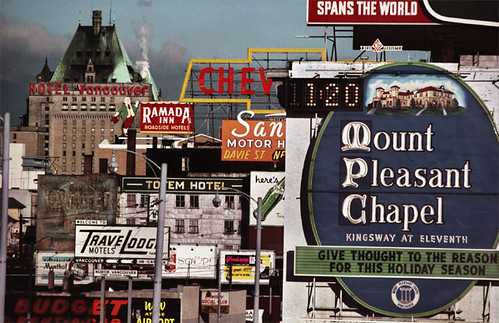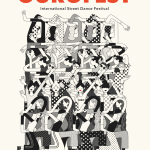Vancouver History Tidbits: Vancouver Neon, Granville Island
The other day I wanted to put up a post about some local history but I wasn’t exactly sure which direction to go. I put the call out on Twitter and received some great questions and responses so I created this tidbits series.
@jbuffoonery – Asked about Vancouver’s neon history
I wrote my own post about a Herzog exhibit and featured a photo of my Opa walking down a neon-lit Granville street in he 1950s but I’ve never really gone in-depth about Vancouver’s neon past.
The first neon sign illuminated Granville Street in 1924-25 and at the peak of its popularity in the 1950s there were 18,000 glowing signs in Vancouver along.
By the 1960s abandonment of the inner city for the suburbs meant neon became associated with increasing urban decay. In Vancouver the growing awareness of the city’s natural setting and the decline of the business district along Hastings Street meant the glory days of neon were ending. Opinion-makers and civic leaders were making noises about the “neon jungle” and the “hideous spectacle” neon created. Debate reached absurd proportions when one alderperson blamed neon for litter and prostitution problems.
Bylaws were passed severely limiting the type and size of sign. The unexpected result: a new lack of ambient light. Few realized the role the color and movement from these signs played in creating the spectacle of a lively street (especially in the rain) and it’s not surprising that shortly after the sign bylaws were passed people began discussing the dying downtown. [source: John Atkin]
If you want to check out amazing photograhs of Vancouver during its neon heydays, you need to pick up a book on Fred Herzog or browse his photographic art online.
@CynnamonS – Wanted to know about the industrial past of Granville Island
Granville Island is world-famous for its market (that opened in July of 1979) which is filled with fruits, vegetables, fine meats, cheeses, the freshest seafood and bakery offerings, as well as its theatres and artisan shops filled with metal works and wood carvings. However one may also notice the giant cement plant that is located only a short distance away — a remnant of industrialization on these 38 acres of land (since it’s not technically an island… not now anyway).
The land was originally a mud flat, resembling a simple sand bar, and would often disappear in high tide. Harry Stevens, a Vancouver alderman and President of the Vancouver Board on Trade in the 50s) talked the Federal Government about reclaiming the land in the harbour and was successful.
In 1913 the Pacific Dredging Company began building what we know now as Granville Island (originally called Mud Island by locals) by using fill “sucked up from the bottom of False Creek.” [Vancouver History]. The Island was eventually joined to land and in 1973 its ownership was transferred from the National Harbors Board to the Federal body, CMHC.
The next post in the history tidbits series will contain:
@6oz – The Guinness family’s influence
@kdmurray – Some Burrard Inlet History
@TylerIngram – History of the McBarge
@davidshore – Why the CPR landed in Vancouver (as opposed to Port Moody etc.)















3 Comments — Comments Are Closed
There is a massive renovation happening to the Granville Street in the downtown core currently. From what I have read in the design plans the new street lights are going to be a “homage” to the historical neon lights of old. As well if you are looking for great examples of historical and current neon signs be sure to buzz over to the apply named http://vancouverneon.com/. I used to do Gin & Sin at the old Niagara Pub and miss that great sign of the cascading neon water. http://vancouverneon.com/page_q/niagara.htm
Your Opa’s coat that he is wearing the the photo is still hanging in the downstairs closet. He wore that same coat when he first came to Canada. (he was such a cool guy!)
I just went to a Fred Herzog exhibition in Toulouse. Strange to see all these French people looking at photos of 60’s Vancouver in the south of France. The world really is getting smaller.